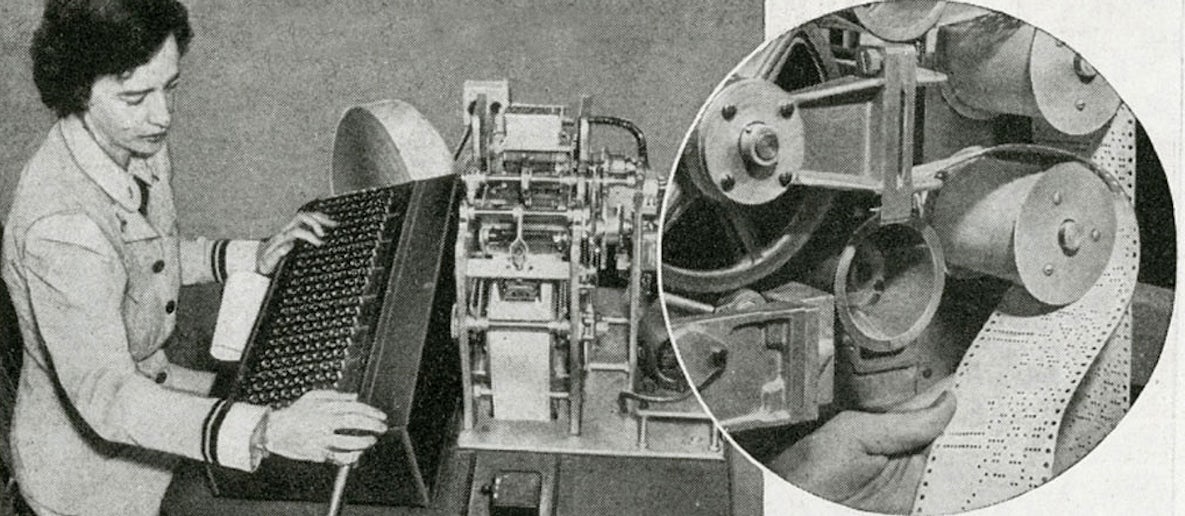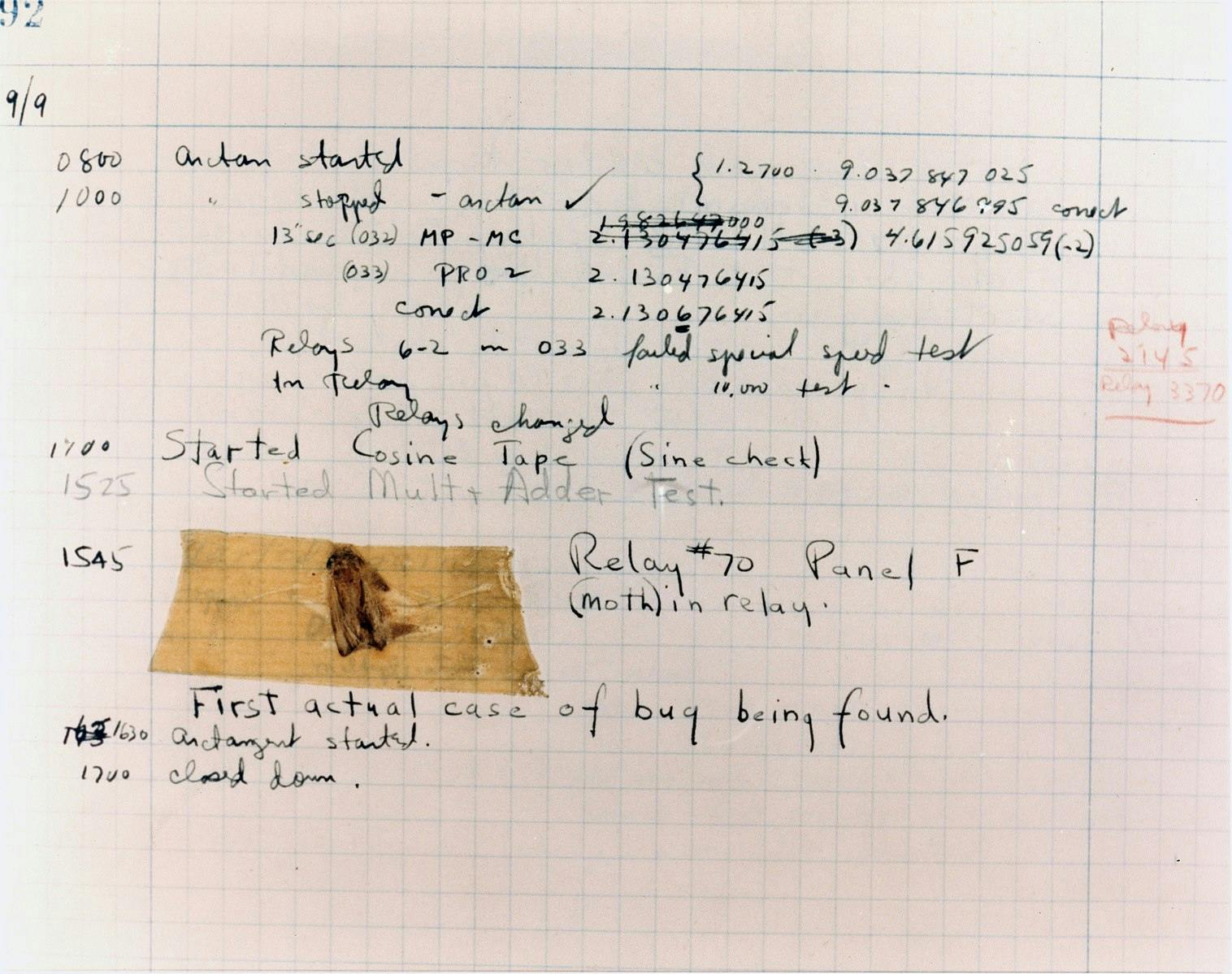
Support Diversity and Inclusion in Tech
CRL has swapped swag gifts for donations to partner organizations like Black Girls Code. Building pathways for young women of color to enter the tech marketplace as builders and creators, Black Girls Code works to provide accessible computer programming and technology skills education.
Learn more about Black Girls CodeLt. Grace Hopper at the programming console for the Mark I computer, 1944. Programming the Mark I required feeding in long rolls of paper punched with holes that the computer translated into instructions.
Back in the days before startups and GitHub and nerds being cool — long before the Internet, and only shortly after there were “computing machines” at all — Grace Hopper was the first person to see that these room-sized citadels of circuitry could do more than mathematical calculations. Grace Hopper theorized and then wrote the first compiler, essentially “teaching” computers to speak English and thereby ushering in the world of computing that we know today.
Grace Hopper is also one of my personal heroes. Six years ago I decided to leave print journalism and retrain as a developer. As a newly divorced, very broke single mom I would be maxing out my credit cards to cover the tuition, not to mention our living expenses during the full-time six month commitment that full stack bootcamp required. It was a gamble. As I researched my new career field, though, I came across a quote from Grace Hopper that I wrote out on a Post-It note and stuck to my screen: “A ship in port is safe, but that is not what ships are built for. Sail out to sea and do new things.”
The more I learned about Grace Hopper’s life and pioneering contributions to early computer technology, the more she inspired me to venture forth fearlessly into the unknown. And then to keep pushing forward through any obstacles planted in my path — with determination, but also humor. Her irreverent, deadpan wit was on full display the time David Letterman invited her to appear on his show:
Letterman: How did you know so much about computers?
Hopper: I didn’t. It was the first one.
Despite her fifteen minutes of late night tv fame, many people — especially those outside of tech — have never heard of Grace Hopper. Our girl geek goddess Grace’s contributions to modern computing remain relatively obscure, despite the fact that there is a US Navy battleship — the U.S. Navy Arleigh Burke class guided-missile destroyer USS Hopper (DDG-70) — named in her honor, as well as the Cray NE6 supercomputer “Hopper” at NERSC. In 2016, President Barack Obama awarded Grace Hopper the Presidential Medal of Freedom even though she died in 1992. How badass is that?
So, with hopes of spreading the legend of Amazing Grace a little bit wider, here is a small tribute to Grace Hopper in honor of her 116th birthday.
The story of Grace Hopper
Early days
Grace Murray Hopper was born on December 9th, 1906, to a wealthy upper-class family in New York City. (Happy 116th, Grace!). She was a natural-born tinkerer who even in early childhood demonstrated determined curiosity about how things worked. There is a tale of how, at the age of seven, Grace wanted to find out how alarm clocks worked. She dismantled her own, but was unable to reassemble it so that it worked. Undaunted, she took apart six more of her family’s clocks – until her mother caught on to Grace’s project and took away all but one of them. This story illustrates both our heroine’s intellectual curiosity and determination to solve problems that interested her, and also that her family supported it. In a time where few girls went any further than primary school and a woman’s “highest calling” was being a stay at home wife and mother, the Murrays celebrated Grace’s questing intelligence. Her parents encouraged their daughter not only to pursue higher education, but also to follow her “unfeminine” interests in math and physics.
This encouragement was at least partly for pragmatic reasons: Grace’s father suffered from arterial disease and had to have both legs amputated, which was the only form of treatment available a century ago. Expecting to die well before his daughters, Walter Murray insisted that Grace and her sister Mary be well educated to support themselves, should they ever need to. Walter Murray ended up living a long life, getting around on two wooden legs and two canes while running his own insurance company and even playing golf. Grace adored her father and, later in life, said that his cheerful determination to succeed in the face of severe setbacks was what inspired her own notable perseverance. After all, if her father could thumbtack his socks to his mahogany shins and keep on going, then there should be no obstacle too difficult for her to overcome.
This can-do attitude gave Grace the gumption to pursue career paths that very few women had ever even dreamed of, let alone attempted to reach.
College Years
Grace went to Vassar College and in 1928 graduated with twin bachelor’s degrees in physics and mathematics. She then moved on to Yale, earning first a master’s and then a Ph.D. in mathematics in 1934. She joined the faculty at Vassar, teaching courses in subjects like finite differences, operational research, and probability game theory – knowledge that paved her future path to computing. She also took advantage of Vassar’s policy allowing faculty to audit any and all courses offered at the college, making a point of sitting in on two courses each semester. In this way Grace learned the fundamentals of astronomy, biology, geology, architecture, and much more. Later in life she credited this broad foundation for her forward-thinking innovations in computing. She found it fascinating that each discipline had its own language and symbols – a fascination that led directly to her pioneering creation of computer compilers and new programming languages.
While in graduate school Grace Murray also married Vincent Hopper, in 1930. They had no children and divorced in 1945, whereupon he immediately married one of her best friends (ouch). Grace went by her married name for the rest of her life and never spoke of the divorce, which was highly stigmatized in that era. But then she also never moved to discredit the widely-circulated (by no less than the New York Times) tale that she had been widowed during WWII. (Vince died in 1976 after a career in academics teaching Renaissance literature. No battleships have been named after him).
WWII & the Navy Reserve
World War II arrived and Grace Hopper eagerly left academia to enlist in the Navy Women’s Reserve. Thanks to her mathematics PhD she was assigned to Harvard’s Cruft Laboratories, where the navy’s Bureau of Ships Computation Project had just commandeered the Mark I computer, as the Automatic Sequence Controlled Calculator, for wartime use. Grace joined the programming staff headed by Howard H. Aiken and learned computer programming first-hand on one of the world’s very first computers…Which had a maximum capacity of 72 words of storage.
The Mark II
When the war ended, she continued to serve in the Navy Reserve. Hopper turned down a full professorship at Vassar in favor of working as a research fellow under a Navy contract at Harvard, where she was part of the team building the Mark II computer. In interviews given later in life, Grace said she had “Literally grown up with the Mark II” which took two years to build — and 20 tractor trailer trucks to move it to its final home installation at the Naval Surface Weapons Center. The Mark II was the source of one of the most enduring myths about Grace Hopper: that she invented the term “debugging.”
As the story goes, she was working on the Mark II at the time, in an old building with tattered window screens. The summer of 1945 was warm, and the windows were always open. One day the behemoth computer malfunctioned, and the team finally found the cause: there was a moth inside one of the Mark II’s relays. An operator carefully fished it out with tweezers, taped it into the log book, and wrote “first actual bug found.”

This log book, and the bug, are both now enshrined in the Smithsonian Museum, but in actuality the term “computer bug” was already in use by this time, and contemporary newspaper reports about the moth incident say nothing about Hopper authoring the term. However, she was part of the team documented as coining both the term and the practice of “debugging.” (She’d pretty much have to be; odds are excellent, since in 1947 there were literally four computers in the entire world).
The A compiler
It was after Grace Hopper’s move to the world of civilian commercial computing, however, when she made her greatest contributions. In 1949, Hopper — still an officer in the Naval Reserves — joined the Eckert–Mauchly Computer Corporation (eventually the Rand Corporation) as a member of the team developing the UNIVAC I. The dev team had a pact, Grace used to explain, “If the UNIVAC failed, we would throw it out one side of the building, where there was a junkyard, and then we would jump out of a window on the other side, where there was a graveyard.”
However, the UNIVAC did succeed, and it was here, in the early 1950s, that her original compiler work was done. It was while working on UNIVAC that Grace Hopper pioneered the development of programming languages that could be translated (or compiled as we now say) for computers to run. At that time, programs had to be written in machine language. She argued that it would be much easier to have programmers write in a version of English and set about building the first compiler. She called it “the A compiler”; the first version was A-0.
She came up with the term “compiler” to describe the process, she said because just as researchers went to libraries to compile information from books, the computer was compiling its own information from its library of subroutines. By 1952 Grace Hopper had an operational compiler.
“Nobody believed that," she said. “I had a running compiler and nobody would touch it. They patiently explained to me that computers could only do arithmetic.” However, her bosses quickly realized the value of her invention and compilers became the basis for what was called “automatic programming”. Or, you know, that thing we still do today.
She then wrote the first two compiler-based programming languages, MATH-MATIC and FLOW-MATIC. These were not only the first compiler-based languages but also the first English-like processing languages. They were the basis for COBOL (Common Business Oriented Language), which Hopper helped create in 1955. COBOL is still in use today in part because the simple syntax allows non-programmers — “The Business” — to read and understand it. (Fun fact: 95% of ATM swipes use COBOL code, so maybe send a mental thanks to Grace Hopper next time you hit the bank machine).
Subroutines and distributed systems
Grace Hopper had many more “firsts” in her long and productive career, including two other major paradigm-shifting ideas that she pioneered.
Hopper’s breakthrough vision was that computers could serve as the primary vehicles for their own operation, rather than needing to be fed a series of detailed instructions every time a program ran.
First was Hopper’s breakthrough vision that computers could serve as the primary vehicles for their own operation, rather than needing to be fed a series of detailed instructions every time a program ran — the same set of instructions, every time. Thus every new program required pages upon pages of the same duplicate code to be written by hand and fed into the machine. Grace Hopper was among the first people to recognize that these instructions could be enshrined as “subroutines” — another term she coined — and saved within the computer to be called up and assembled, as needed, into an appropriate program. She designed a system of frequently used subroutines, then assigned them three-letter call signs that the computer could use to retrieve the instructions from its library of stored tapes. What had previously taken a month of manual coding could now be done in five minutes.
Next, in the 1970s, Grace Hopper was instrumental in persuading the military of the value in moving from large, central computing systems to distributed networks of small computers where any user on any node could access common databases. Once again, like compilers, computer networks were a revolutionary idea quickly copied by the commercial computing industry once the military and government introduced it. How important was this? Well, Hopper’s model of small distributed clusters of programming and storage is the foundation of a little thing we like to call the internet, not to mention cloud computing.
Grace Hopper was eventually promoted to the rank of “Rear Admiral, lower half” (this means she was at the first tier of the two-level rank, not that only the bottom half of her actual torso got to be an Admiral) and was one of the longest-serving active duty commissioned officers in US Navy history. She actually retired several times, but each time the Navy called her back to work before the ink on her discharge papers had fully dried. She finally retired for good on August 14, 1986, at the age of 79 — and the next day started work as a senior consultant for Digital Equipment Corporation. She never missed a day until her death (from natural causes) in 1992.
Grace Hopper was buried with full military honors at Arlington National Cemetery. Though her profound contributions to modern computing haven’t exactly made “Grace Hopper” a household name even among software geeks, she has had some pretty cool honors come her way. These include the aforementioned Presidential Medal of Freedom and battleship named after in her honor, as well as her own Google Doodle in 2013 – an animation of Grace sitting at UNIVAC, using COBOL to print out her age (107 at the time) as a moth flies out of the computer (et tu, Google?).
The list of things named in Grace Hopper’s honor goes on and on, spanning 6 decades (and counting). The University of Maryland hosts a Cray XC-30 supercomputer nicknamed “Grace”, and the Grace Hopper Celebration of Women in Computing is an annual conference promoting the contributions and research of women in computing. Google named their most recent transatlantic subsea cable, from the US to the UK, in her honor. NVIDIA named its breakthrough accelerated CPU, designed for giant-scale AI and high-performance computing applications, the Grace Hopper Superchip. My favorite of her many recognitions, though, is when in 1969 the Data Processing Management Association awarded Grace Hopper their first-ever Computer Sciences Man of the Year Award. (Presumably this org was better at data processing management than they were at naming awards).
So, happy birthday, Amazing Grace! And thank you. The iMac whose screen held your inspirational quote about sailing out to do new things is now four computers ago, but I still have the Post-It note. Your words helped me a great deal in those early unsure days. The perseverance you modeled while blazing a fearless path for future female programmers to follow helped even more. It’s unlikely I will catalyze any technological breakthroughs during my now-successful second act career in tech. By teaching, volunteering, and mentoring, however, I am doing my best to help widen the path you blazed so that ever more women and other folks under represented in this industry can find their way, too.


